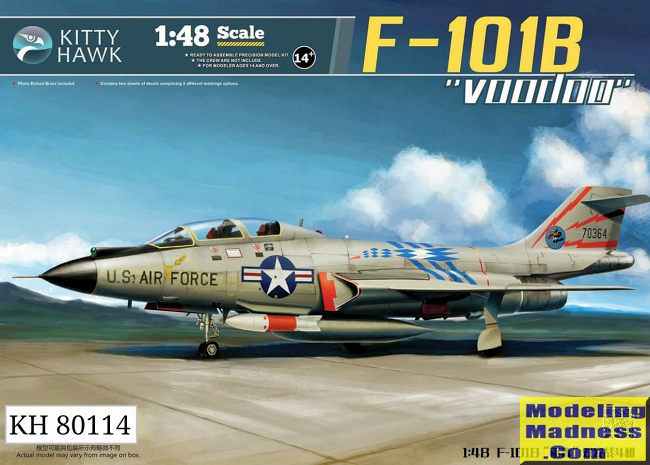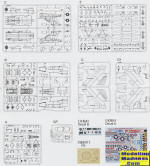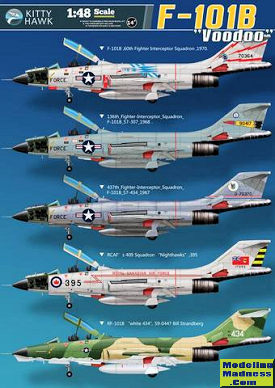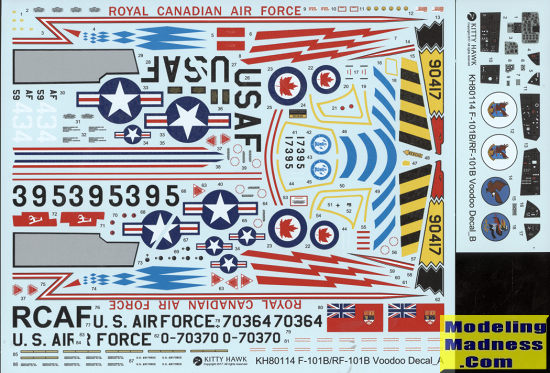
Kitty Hawk 1/48 F-101B Voodoo
| KIT #: | KH80114 |
| PRICE: | $80.00 SRP |
| DECALS: | Five options |
| REVIEWER: | Scott Van Aken |
| NOTES: | Includes photo etch parts. |

| HISTORY |
Although McDonnell proposed the designation F-109 for the new aircraft (which was to be a substantial departure from the basic Voodoo), the USAF assigned the designation F-101B. It was first deployed into service on 5 January 1959, with the 60th Fighter-Interceptor Squadron. The production ended in March 1961. The Voodoo featured a modified cockpit to carry a crew of two, with a larger and more rounded forward fuselage to hold the Hughes MG-13 fire control radar of the F-102. It had a data link to the Semi-Automatic Ground Environment (SAGE) system, allowing ground controllers to steer the aircraft towards its targets by making adjustments through the plane's autopilot. The F-101B had more powerful Pratt & Whitney J57-P-55 engines, making it the only Voodoo not using the −13 engines. The new engines featured a substantially longer afterburner than J57-P-13s. To avoid a major redesign, the extended afterburners were simply allowed to extend out of the fuselage by almost 8 ft (2.4 m). The more powerful engines and aerodynamic refinements allowed an increased speed of Mach 1.85.
The F-101B was stripped of the four M39 cannons and carried four AIM-4 Falcon air-to-air missiles instead, arranged two apiece on a rotating pallet in the fuselage weapons bay. The initial load was two GAR-1 (AIM-4A) semi-active radar homing and two GAR-2 (AIM-4B) infrared-guided weapons with one of each carried on each side of the rotating pallet. After the first two missiles were fired, the door turned over to expose the second pair. Standard practice was to fire the weapons in SARH/IR pairs to increase the likelihood of a hit. Late-production models had provision for two 1.7-kiloton MB-1/AIR-2 Genie nuclear rockets on one side of the pallet with IR-guided GAR-2A (AIM-4C) on the other side. "Project Kitty Car" upgraded most earlier F-101Bs to this standard beginning in 1961.
From 1963–66, F-101Bs were upgraded under the Interceptor Improvement Program (IIP; also known as "Project Bold Journey"), with a fire control system enhancement against hostile ECM and an infrared sighting and tracking (IRST) system in the nose in place of the in-flight refuelingprobe.
The F-101B was made in greater numbers than the F-101A and C, with a total of 479 being delivered by the end of production in 1961. Most of these were delivered to the Air Defense Command (ADC) beginning in January 1959. The only foreign customer for the F-101B was Canada.
The F-101B was withdrawn from ADC service from 1969 to 1972, with many surviving USAF aircraft transferred to the Air National Guard (replacing F-102s), serving until 1982. The last Voodoo in US service (F-101B-105-MC, AF Ser. No. 58-300) was finally retired by the 2nd Fighter Weapons Squadron at Tyndall AFB, Florida on 21 September 1982.
| THE KIT |
 This
is a follow-on to their previous F-101A/C kit of a few years back and as such is
one that will be welcomed by many modelers. Other than the tail section and
wings along with the landing gear, there are a lot of new sprues in this kit to
enable you to properly build the two seat F-101B. Some may wonder why this was
released as the Monogram kit was fine. It still is fine, but this kit provides a
level of detail that many modelers want to have.
This
is a follow-on to their previous F-101A/C kit of a few years back and as such is
one that will be welcomed by many modelers. Other than the tail section and
wings along with the landing gear, there are a lot of new sprues in this kit to
enable you to properly build the two seat F-101B. Some may wonder why this was
released as the Monogram kit was fine. It still is fine, but this kit provides a
level of detail that many modelers want to have.
Interestingly, the kit starts you off building up the center fuselage. This consists of a full intake section and the afterburners. Once the rear keel between the exhaust is added, then the upper fuselage section and burner cans are added. There are p.e. bits to fit into the burner cans. KH then has you build up the wings complete with the landing gear. Ailerons are separate and the flaps can be posed lowered. The splitter plate has seven p.e. standoffs to apply.
Once that is done, the wings and fin can be attached to the fuselage. On the fuselage are air scoop inserts and you have the option to have the speed brakes open or closed. This is when the rudder and horizontal stab are installed as is the tail hook.
 It is only
halfway through the build that the cockpit is assembled. The kit has four piece
bang seats with p.e. harness. P.e is also used for the instrument panels and
side consoles. You have decals you can place over these if you wish. Kitty Hawk
provides a nose full of avionics, which is also the forward bulkhead of the
cockpit. This and the cockpit are then attached to the nose gear well. Again,
instructions show the nose gear assembly being built up prior to closing the
nose halves.
It is only
halfway through the build that the cockpit is assembled. The kit has four piece
bang seats with p.e. harness. P.e is also used for the instrument panels and
side consoles. You have decals you can place over these if you wish. Kitty Hawk
provides a nose full of avionics, which is also the forward bulkhead of the
cockpit. This and the cockpit are then attached to the nose gear well. Again,
instructions show the nose gear assembly being built up prior to closing the
nose halves.
The weapons bay is then constructed with Falcons on one side and a Genie on the other. This bay is then attached to the cockpit assembly and the forward fuselage haves assembled. Following this, various strakes and inserts are installed along with a radar antenna. The upper nose can have either the refueling door or the infrared seeker. Four of the five options will use the seeker. It is only now that the nose is mated to the rest of the fuselage.
You are provided the RF-101B camera add on if you wish to do the one option provided. This simply attaches to the bottom of the nose and you don't use the seeker on this one. For the interceptor, a simple plate attaches to the lower nose. Avionics bay doors can be posed open as can the canopy. The only 'things under wings' are fuselage mounted fuel tanks.
 Instructions
are well drawn and provide notes on the different options available. Any colors
required during the build are also provided. There are five markings options.
The RF-101B is in SEA camouflage with no unit markings. The Canadian plane with
409 squadron is in Canadian Voodoo Grey, a color sadly removed from paint lines
a few years ago. The instructions recommend FS 16440 light gull grey, but that
is really not the right shade. The box art plane is with the 60th FIS in 1970.
It is listed as FS 16440 also, but that is incorrect as most USAF F-101Bs were
in overall ADC grey (FS 14673). The 136 FIS, New York ANG plane from 1968 is
also in this shade. The fifth option is shown as overall silver with the 437th
FIS in 1968.
Instructions
are well drawn and provide notes on the different options available. Any colors
required during the build are also provided. There are five markings options.
The RF-101B is in SEA camouflage with no unit markings. The Canadian plane with
409 squadron is in Canadian Voodoo Grey, a color sadly removed from paint lines
a few years ago. The instructions recommend FS 16440 light gull grey, but that
is really not the right shade. The box art plane is with the 60th FIS in 1970.
It is listed as FS 16440 also, but that is incorrect as most USAF F-101Bs were
in overall ADC grey (FS 14673). The 136 FIS, New York ANG plane from 1968 is
also in this shade. The fifth option is shown as overall silver with the 437th
FIS in 1968.
 I'm going
to be doubtful of this color callout as well until I see a photo of the aircraft
in question. The decal sheet is very nicely printed and quite colorful. I think
the ANG badge might be a little too light a blue, but that is a small detail.
Those wondering why no buzz numbers have to look at the dates of these planes.
By the mid-late 1960s those had often been removed. If you wish to add them,
there are decal letter sheets in this font that you could use to piece them
together.
I'm going
to be doubtful of this color callout as well until I see a photo of the aircraft
in question. The decal sheet is very nicely printed and quite colorful. I think
the ANG badge might be a little too light a blue, but that is a small detail.
Those wondering why no buzz numbers have to look at the dates of these planes.
By the mid-late 1960s those had often been removed. If you wish to add them,
there are decal letter sheets in this font that you could use to piece them
together.
| CONCLUSIONS |
| REFERENCES |
https://en.wikipedia.org/wiki/McDonnell_F-101_Voodoo
June 2018
Copyright ModelingMadness.com. All rights reserved.
Thanks to
Kitty Hawk for the review kit. Get yours today at your favorite retailer.If you would like your product reviewed fairly and fairly quickly, please contact the editor or see other details in the Note to Contributors.
Back to the Main Page Back to the Review Index Page Back to the Previews Index Page